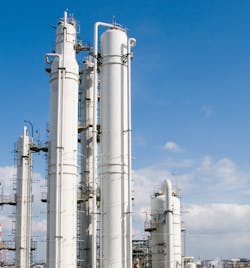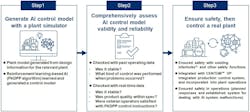Full-Scale Distillation Control Project Demonstrates Process Autonomy Using Artificial Intelligence
Autonomous process control in chemical manufacturing has passed a major milestone with a new installation for a distillation process. The Eneos Materials Corp. plant in Japan needed to regulate a distillation column (lead image) that the company couldn’t fully automate using conventional proportional, integral, derivative loops – or even advanced process control strategies. Instead, operators had to manually control critical valves to regulate liquid levels in the column trays to maintain production specifications. The lack of automation also meant the plant couldn’t maximize cost savings from using waste heat in the process.
Eneos turned to artificial intelligence (AI) to overcome several challenges in the distillation process, including:
• The critical product and byproduct were difficult to separate due to their similar boiling points.
• A conventional boiler heats the column. The plant captures waste heat from other processes to reduce cost and improve sustainability, but waste heat supply is variable. Operators must balance the two types of sources.
• The plant is located in an area with varying weather patterns, including daily temperature fluctuations and rain, which can change column conditions.
• The plant needed precise control of temperature, bottom levels and yield to ensure product streams from the tower met specifications.
Putting AI to Work
For this type of process control application, Yokogawa uses a conceptually straightforward approach (Figure 2). It begins with a plant simulator. This can be an existing platform created previously for analysis and training purposes, and then modified for this type of project, or one commissioned for a specific AI project.
The project includes the use of factorial kernel dynamic policy programming (FKDPP), a reinforcement learning-based AI algorithm, to study the simulator until it creates its robust control model through about 30 learning trials. After generating the model, the team tests for validity by applying it against actual historical operating data and real-time data from the process. Once the model has passed the test, the plant’s technical team validates that it correctly interfaces with all related safety and alarm systems. At this point, it’s ready to control the actual process.
Yokogawa first developed its FKDPP algorithm as a joint project with the Nara Institute of Science and Technology in 2018. The algorithm’s reinforcement learning techniques allow the system to perform multiple trial-and-error cycles, experimenting with the process to calibrate how it works. In Yokogawa’s developments with simulators and small-scale deployments, most applications develop sufficient knowledge to achieve stable operation in as few as 30 cycles.
In many respects, it’s similar to a model-based control strategy. However, the capacity for self-learning, along with the robustness of the control model that can cope with some disturbances, are very important features of autonomy — especially compared to conventional models that must be continuously updated by plant personnel to remain effective.
Implementation from Both Sides
Yokogawa and Eneos Materials worked together to install the system (Figure 3).
Eneos Materials provided:
• Specific process challenges for the AI control system to solve
• The production unit venue with detailed plant information, operating status and historical process data
• Connectivity with the unit’s existing Yokogawa Centum VP integrated production control system
• Evaluation of safety and alarm interfaces from the perspective of the AI control system
Yokogawa provided:
• All planning and scheduling proposals
• AI system design
• All engineering necessary to support integration with the Centum VP system
• Maintenance required to prepare the unit’s instrumentation and control infrastructure
Additional technologies included:
• OmegaLand plant simulator, provided by Yokogawa subsidiary Omega Simulation Co.
• Exaopc OPC interface package to enable management of external supporting databases using interfaces compliant with the OPC foundation
• GA10 data logging software for operation screen, input device and data recording
Defining Success
A project such as this must have a clear, quantifiable definition of success to justify the investment. In this case, Eneos Materials’ process, as it previously existed, could produce on-spec product cost effectively most of the time, except for occasional, brief upsets. But small, critical process inconsistencies hindered production, and the column required regular manual valve trimming to remain optimized, a task with varying results because it was dependent on operator expertise.
For this reason, Eneos Materials defined project success as a stable, fully self-governing process, capable of continuously producing high-quality, on-spec product driven primarily by recovered waste energy.
Achieving these goals would increase output while reducing energy costs. In addition, it would free operators for higher-value tasks as they’d no longer need to adjust control of the distillation column. The demonstration project also required the column to run for at least 30 days totally under the AI’s control during a time window ahead of a scheduled unit turnaround to be considered successful.
Favorable Outcome
The AI system maintained continuous control for a period of 35 days (January 17 to February 21, 2022) until it was shut down for regular annual maintenance. During this period, it yielded only quality product, equaling average periods of normal unit operation. It maximized use of waste energy, reducing carbon dioxide emissions, and it did not require manual operator intervention.
By combining both companies’ know-how and focusing on areas that proved resistant to full automation, it was possible to demonstrate the specific capabilities of reinforcement-learning AI in systems and operations. The results suggest this technology can significantly contribute to the evolution of automation to autonomy, while maximizing ROI and environmental sustainability at plants around the world.
“In an environment that is changing due to factors such as the fully-fledged introduction of 5G and other developments towards a digital society, as well as the aging of the human resources who ensure plant safety and a lack of human resources to replace them, the petrochemical industry is under strong pressure to improve safety and efficiency in its production activities by utilizing new technologies such as IoT and AI,” says Masataka Masutani, division director of production technology at Eneos Materials.
For offshore oil fields and other facilities and process plants, there is an increasing need for remote autonomous operations. This field test demonstrated AI can autonomously control a critical plant process in an on-site setting.
About the Author
Kenji Hasegawa
Yokogawa Electric vice president and head of Yokogawa Products Headquarters
Kenji Hasegawa is a Yokogawa Electric vice president and head of Yokogawa Products Headquarters. Since joining Yokogawa in 1985, Mr. Hasegawa has held a wide range of positions in global sales, business strategy and planning, along with global marketing for IA and IT products, systems, and solutions. In his current role, he is responsible for Yokogawa’s core IA products and service business globally. He graduated with a degree in physics from Waseda University in Tokyo.



